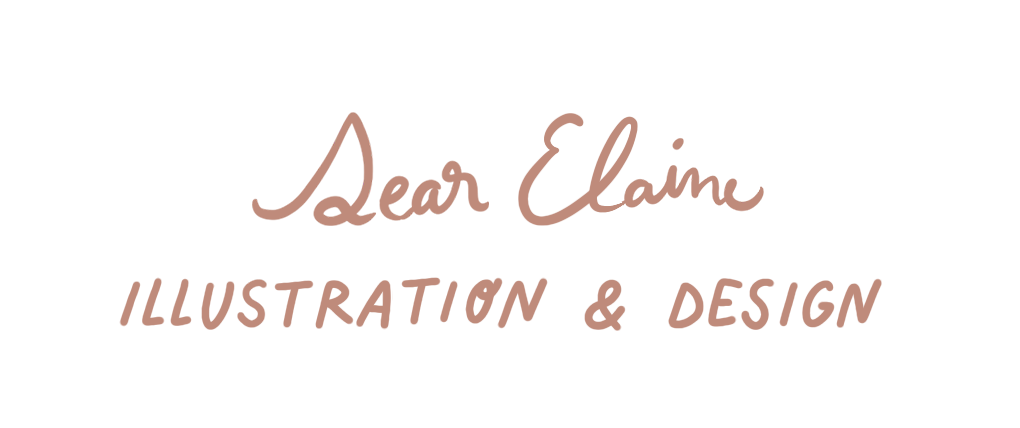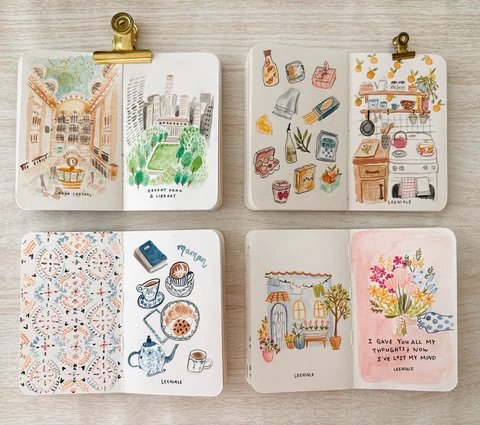Tackle the Blank Page: Drawing Tips for Beginners
“Dear Elaine,
Any suggestions for folks who want to try painting/sketching for the first time but are too afraid to try? - K.L.”
"Don't be afraid to fail. Be afraid not to try." - Michael Jordan.
(Lol the cheesiest quote ever but it came to mind 😂)
It's normal at the beginning of your art journey to feel unsure of where to begin!
I was there not too long ago actually! I started actively drawing and painting in August of 2018. I had loved illustration as a child but grew out of this art hobby as I got busier with work and life.
So yeah, I know exactly how you’re feeling. It was only a few years ago when my hands were shaking because they hadn’t held a pen with that firm of a grip in so long. My lines were wobbly and unconfident. I remember feeling disheartened but at the same time realized that it was a muscle memory that I needed to train.
Though I had studied art and design in school. It had been many years since I opened up a sketchbook. As an adult, I was re-learning how to paint and draw all over again!
So i know, starting on a blank page can be intimidating.
But it's all about having a growth mindset, embracing the learning process, taking up the challenge, and seriously having fun!!!
I hope that from this short read, you will be helped to let go of the pressure for perfection on that blank page and realize that your sketchbook is a safe space for growth and exploration. 🎨 🌱
Here are some practical steps to help you get started when you're not sure of where to begin or what to draw.
Find your creative guides
Find artists who inspire you and whom you aspire to be like.
Take them as your imaginary mentors! Learn all you can from them: watch their videos, save their content, and mimic their style. "Steal Like an Artist" by Austin Kleon is a great read I would recommend. This book will open your eyes what’s available and help you unleash your creativity!
It’s okay to be super inspired by other artists at the beginning of your journey. You’re just learning, experimenting with different art mediums, and finding your style and artistic voice. Of course, when you recreate another artist’s work, remember to credit them 💖 (Note: Usually, when you credit the artist that inspired you, it’ll flatter them!)
I can list SO many artists that inspired me at the beginning of my art journey, and they still inspire me!
Some are art nouveau artists, modern-day graphic artists, loose floral watercolor artists, film directors, etc.
I love collecting their art and creating an inspiration board full of them. This helps me understand what colors and styles I like and inspires me to create! Then hopefully find my own style one day!
👉 So, if you don’t have a folder or clippings of artwork from other artists, then try creating one.Create your creative space
Find space in your apartment to dedicate as your creative space!
I’ve been through my share of small apartments. 450 sq ft shared two bedroom NYC apartment?
Been there, done that. 😂
So, for me, my creative space is wherever my three-tiered art cart is! Usually I set up my art supplies on the dining table next to a warm window and if I’m able to keep my art supplies laid out for a few days then it’s easier for me to jump right into creating the next time!
Also, take my artist friend Sanae for example. She told me that when her apartment in Boston was too small to paint in, she transformed her apartment’s stairwell into her personal studio (since no one ever used the stairs)! And it was perfectly lit next to a large window! ☀️ It's remarkable how inventive you can be with limited space.
Of course if you have a room you to call your studio or a desk just for your creative pursuits then that’s amazing! But the point is to give yourself less obstacles and less excuses to get creative!
Try carving out your creative space. ✨Master drawing chickens
Pick simple subjects to draw and get really good at them!
In some months, I would designate one subject as that month’s art theme. By doing this, you’ll get really good at that one subject! Whether it be flowers, landscapes, ribbons or chickens. 🐓 You can experiment and explore different styles and art mediums to depict those subjects.
So what’s the subject you want to master this month?Gather inspiration
There is inspiration everywhere!
It’s right outside of your window or all around you when you go for a walk. 🌼 If you keep visual inspiration easily accessible then you will never run out of things to draw! Even when you have artist block you can pull from folders or a photo pile of inspiring images waiting to be drawn.
Here are some ways I find visual inspiration:
〰️ Pinterest: Create boards and collect pins of things to draw. Cozy interiors, still life, flat lays, flowers—pin whatever catches your eye! Here's one of my boards I save for days I feel uninspired. ☔️
〰️ Tutorial Videos: There are countless tutorials available on the interwebs! Find one that interests you and follow along. I have 60+ short videos on how to draw different species of flowers that you can check out too!
〰️ Your Own Photos: Scroll through your personal photo collection! Is there something interesting or inspiring that you could draw? Maybe it's a photo of something you ate or a memorable moment captured.
Now print out or keep those chosen images handy! 📸
5. Warm-up exercises
Imagine this, you’ve worked a long day on your computer using a mouse and keyboard and then all of a sudden you decide to start sketching a masterpiece. But…your sketch isn’t quite turning out the way you imagined and you feel like you suck at art. Does this sound like anyone else? 🙋🏻♀️
Well maybe… before diving into your drawing you could start with some warm up exercises for those stiff fingers! 😉
Here's a simple warm-up exercise you can try:
Materials needed:
Inspiration photo, a few colored pencils or a pen/pencil, a piece of paper or sketchbook
1. Keep the inspiration photo nearby and study it for a minute. Notice the details, composition, highlights, and shadows.
2. Set a timer for 10 seconds and quickly sketch the image on a piece of paper with a pencil or pen. Time's up!
3. Repeat the process, increasing the time to 20 seconds, then 45 seconds.
4. These quick sketches aren't meant to be perfect—they're meant to loosen up your fingers and help you see your inspiration with a fresh perspective. Look for interesting marks and details that might inspire your final drawing.
6. Start Small
As a beginner, starting small can be helpful. Consider using a pocket-sized sketchbook. This way, you can finish your drawings in one sitting, which helps avoid feeling discouraged when time is limited. Aim for 15-30 minutes per page. Remember, you can always add paint or work on it more later if you want!
If you're looking for a sketchbook then check out my video on my favorite art supplies. I’ve also designed a sketchbook that is a great size for beginners here.
7. Enjoy the Process
For me, art is therapeutic—a way to calm my mind and focus on the task at hand.
Use your drawing time as an opportunity to escape the chaos and noise of the outside world. Embrace the process and enjoy the quietness of creating.
And don't be too critical of yourself if your results don't match your vision.
We all start somewhere, and we all have good and bad days. Keep those sketchbook pages, as they can serve as a reminder of your progress over time. 💕
8. Lastly, Reflection (Optional)
When you are ready to improve your skills then it’s time to reflect.
Look back at your illustration and reflect on how you can improve. Did you face any challenges? Take advantage of the abundance of tutorials and free resources available online. Study other artists' styles and approaches to similar subjects—you might discover a new way to draw!
Be someone who is always learning.
P.S. For my visual learners, I'll be releasing art classes soon. Stay tuned and sign up for my mailing list to be the first to know!
Happy creating!
x Elaine
Disclaimer: As an Amazon affiliate I earn a small commission from qualifying purchases at no cost to you.




